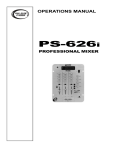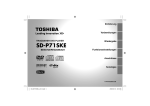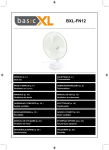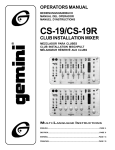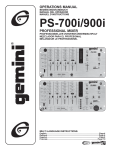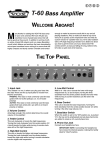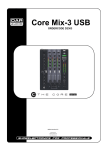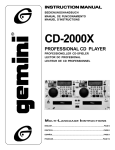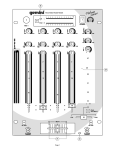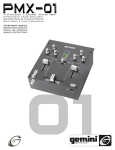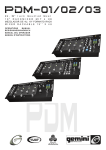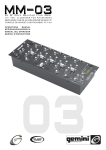Download PS-626i/676i
Transcript
OPERATIONS MANUAL BEDIENUNGSHANDBUCH MANUAL DEL OPERADOR MANUEL D’INSTRUCTIONS PS-626i/676i PROFESSIONAL MIXER PROFESSIONNELLER VORVERSTÄRKERMISCHPULT MEZCLADOR PARA EL PROFESIONAL MÉLANGEUR LE PROFESSIONNEL MULTI LANGUAGE INSTRUCTIONS: English......................................................................................................Page 4 Deutsch....................................................................................................Page 6 Español.....................................................................................................Page 8 Francais.................................................................................................Page 10 (1) (2) 35 13 34 25 29 26 28 30 27 24 23 22 20 21 20 20 19 18 21 19 19 40 21 18 18 41 37 36 39 38 31 32 33 36 36 3 PS-626i 16 2 47 35 13 53 46 34 25 45 45 45 26 51 28 50 27 24 23 22 20 21 20 20 19 18 21 19 19 40 21 18 18 41 52 36 36 36 36 38 31 32 33 39 3 PS-676i 48 44 16 2 BACK 15 1 5 6 7 8 9 10 11 12 5 6 7 8 9 10 11 12 4 17 FRONT 42 43 (3) 14 INTRODUCTION: THE GROUND LIFT SWITCH: Depending on your system configuration, applying the ground sometimes creates a quieter signal path. Sometimes “lifting” the ground eliminates loops and hum to create a quieter signal path. Congratulations on purchasing a GEMINI Platinum Series model PS-626i or PS-676i Mixer. This state-of-the-art mixer is backed by a three year warranty, excluding crossfader and channel slides. Prior to use, we suggest that you carefully read all the instructions. 1. Listen to the system with the unit ON, without music, and with the ground “applied”. GROUND LIFT SWITCH (17) should be to the left. FEATURES: • • • • • • • • Cut Feature for Low, Mid and High of each channel 3 Stereo channels (3 Phono, 3 Line and 1 Mic) 1/4" DJ Mic jack Low, Mid, High and Gain controls on each channel Beat indicators Master, Booth and Record outputs Dual mode display (Left & Right output or Channel 2 and Channel 3) Push button cueing with Cue/Program pan control 2. Turn power OFF before moving the GROUND LIFT SWITCH (17). 3. Now, “lift” the ground by moving the GROUND LIFT SWITCH (17) to the right. Turn the power back ON and listen to determine which position provides a signal free of background noise and hum. NOTE: KEEP GROUND LIFT IN THE GROUND “APPLIED” OR LEFT POSITION IF NOISE LEVEL REMAINS THE SAME IN EITHER POSITION. CAUTION: DO NOT TERMINATE THE AC GROUND ON THE POWER CABLE. TERMINATION OF THE AC GROUND CAN BE HAZARDOUS. PS-676i: • Digital sampler OPERATION: CAUTIONS: 1. POWER ON: Once you have made all the equipment connections to your mixer, press the POWER SWITCH (2). The power will turn on and the POWER LED (3) will glow RED. 1. All operating instructions should be read before using this equipment. 2. To reduce the risk of electrical shock, do not open the unit. There are NO USER REPLACEABLE PARTS INSIDE. Please refer servicing to a qualified GEMINI Sound Products service technician. 2. CHANNEL 1: The GAIN (18), HIGH (19), MID (20), and LOW (21). Controls allows you to fully adjust the selected source. SWITCH (22) allows you to select either the MIC (13) or the PHONO 1/LINE 1 (12) input. The CHANNEL (25) slide controls the output level of this channel. In the USA: if you experience problems with this unit, please call 1 (732) 738-9003 for GEMINI Customer Service. Do not attempt to return this equipment to your dealer. 3. MAIN CHANNEL SECTION: To assign an input source to a channel, first set the PHONO/LINE (23,24) switches to their appropriate positions. To make the proper adjustments to your music, set the GAIN (18), HIGH (19), MID (20), and LOW (21) controls and position the CHANNEL (26,27) slide. 3. Do not expose this unit to direct sunlight or to a heat source such as a radiator or stove. 4. This unit should be cleaned only with a damp cloth. Avoid solvents or other cleaning detergents. PLEASE NOTE: THERE IS LOW, MID AND HIGH EQUALIZATION FOR EACH CHANNEL WITH AN EXTREMELY WIDE RANGE OF ADJUSTMENT. SUGGESTION: YOU CAN USE THE CUT FEATURES ON EACH CHANNEL TO REMOVE LOW, MID AND/OR HIGH RANGE TO CREATE SPECIAL EFFECTS. 5. When moving this equipment, it should be placed in its original carton and packaging. This will reduce the risk of damage during transit. Your Gemini mixer comes with an RG-45 PRO (RAIL GLIDE™) DUALRAIL CROSSFADER. RAIL GLIDE™ Crossfaders have internal dual stainless steel rails that allow the slider to ride smoothly and accurately from end to end. Gemini replacement Crossfaders are available in three varieties: the RG-45 PRO (RAIL GLIDETM) Dual-Rail Crossfader; the RF-45, which has a 45mm travel from side-to-side; and the PSF-45, which features a special “curve” designed for scratch mixing.The CROSSFADER in your unit is removable and, should the need arise, can easily be replaced by following these instructions. 6. DO NOT EXPOSE THIS UNIT TO RAIN OR MOISTURE. 7. DO NOT USE ANY SPRAY CLEANER OR LUBRICANT ON ANY CONTROLS OR SWITCHES. CONNECTIONS: 1. Before plugging in the power cord, make sure that the VOLTAGE SELECTOR (1) switch is set to the correct voltage. NOTE: THIS PRODUCT IS DOUBLE INSULATED AND IS NOT INTENDED TO BE GROUNDED. 2. Make sure that the POWER (2) switch is in the off position. The POWER LED (3) will be off. 3. The PS-626i/676i is supplied with 4 sets of output jacks. • The 1/4" BALANCED OUTPUT (4) jacks are used to connect to your main amplifier using standard balanced cables. We recommend using balanced amp outputs if the cables to your amplifier are 25 feet or more. • The MASTER OUTPUT (5) (RCA type) jacks are unbalanced and used to connect to your main amplifier. • The BOOTH OUTPUT (6) (RCA type) jacks allow you to hook up an additional amplifier. • The REC OUTPUT (7) (RCA type) jacks can be used to connect the mixer to the record input of your recorder enabling you to record your mix. 5. On the rear panel are 2 stereo PHONO (8, 10) inputs, 2 stereo LINE (9, 11) inputs and 1 stereo PHONO 1/LINE 1 (12) input. The PHONO/LINE (14) switch enables you to set the input to PHONO 1/ LINE 1 (12). The phono inputs will accept only turntables with a magnetic cartridge. A GROUND (15) screw to ground your turntables is located on the rear panel. The stereo line inputs will accept any line level input such as a CD player, a cassette player, etc. 6. Headphones can be plugged into the front panel mounted HEADPHONE (16) jack. 1. Unscrew the outside FADER PLATE SCREWS (B). • Do not touch INSIDE SCREWS (C). 2. Carefully remove old Crossfader and unplug CABLE (D). 3. Plug new Crossfader into CABLE (D) and place back into mixer. 4. Screw Crossfader to mixer with FADER PLATE SCREWS (B). 4. CROSSFADER SECTION: The CROSSFADER (28) allows the mixing of one source into another. The left side of the CROSSFADER (28) is CHANNEL 2 and the right side is CHANNEL 3. 5. BEAT INDICATORS: Each side of the CROSSFADER (28) has its own BEAT INDICATOR (29, 30). They flash at the low frequency peak level allowing you to match the beats visually. BEAT INDICATOR (29) will reflect the beat of CH2 and BEAT INDICATOR (30) will do the same for CH3. 6. OUTPUT CONTROL SECTION: The level of the MASTER (5) output is controlled by the MASTER (31) control. The BALANCE (32) control will allow the Amp Out signal to be balanced between the left and right speakers. The BOOTH (33) control adjusts the level of the BOOTH OUTPUT (6). (4) HINT: BOOTH OUTPUT (6) IS USED BY SOME DJS TO RUN MONITOR SPEAKERS IN THE DJ BOOTH. YOU CAN ALSO USE IT AS A SECOND ZONE OR AMP OUTPUT. NOTE: THE RECORD OUT (7) HAS NO LEVEL CONTROL. THE LEVEL IS SET BY THE CHANNEL SLIDES AND THE GAIN CONTROLS OF THE SELECTED CHANNEL. TONAL QUALITIES ARE SET BY THE LOW, MID AND HIGH CONTROLS OF THAT SAME CHANNEL. 2. When the MODE SELECTOR (44) is in the SINGLE or REPEAT mode, the SAMPLER REC/PLAY LEVEL (46) control acts as a Sampler Level Control. 7. TALKOVER SECTION: The purpose of the TALKOVER SECTION is to allow the program playing to be muted so that the MIC (13) can be heard above the music. When the TALKOVER (34) button is pushed, the TALKOVER INDICATOR (35) will glow and the volume of all sources except the MIC (13) or whatever is connected to the PHONO 1/LINE 1 (12) input are reduced by 16 dB. 3. Tapping the START/STOP (48) button with the MODE SELECTOR (44) in the SINGLE position will cause the sampler to playback one time (the SAMPLER INDICATOR (49) will illuminate GREEN). Every push of the START/STOP (48) button will restart the sample from the beginning. Rapid pressing of the START/STOP (48) button will cause a stuttering effect. Once the sample has started playback and the START/STOP (48) button is not pushed a second time, the sample will play to the end and then stop (the SAMPLER INDICATOR (49) will illuminate turn off). 8. CUE SECTION: By connecting a set of headphones to the HEADPHONE (16) jack, you can monitor any or all of the channels. Select the correct CUE (36) button or buttons and their respective CUE LED (37) indicators will glow. Use the CUE LEVEL (38) control to adjust the headphone volume without effecting the overall mix. By sliding the CUE PGM PAN (39) control to the left you will be able to monitor the assigned cue signal. Sliding to the right will monitor the PGM (program) output. 4. Tapping the START/STOP (48) button with the MODE SELECTOR (44) in the REPEAT position will cause the sample to continuously play over and over (the SAMPLER INDICATOR (49) will illuminate GREEN). The START/STOP (48) button will act as an on/off switch. The first push will start the sample, the second push will stop it. 9. DISPLAY: The peak hold, dual function DISPLAY (40) indicates either the MASTER (5) output left and right levels or the CHANNEL 2 and CHANNEL 3 levels. You can choose the option you want by pressing the DISPLAY (41) button. 1. With the ROBO PLAY (50) button in the OFF position (the ROBO PLAY INDICATOR (51) will be OFF) and the MODE SELECTOR (44) switch in either the SINGLE or REPEAT mode, pressing the START/STOP (48) will cause the sample to play along with the signal going through the mixer. NOTE: WHEN THE DISPLAY (40) IS IN THE CHANNEL 2/CHANNEL 3 DISPLAY MODE, BY ADJUSTING THE INDIVIDUAL CHANNEL GAIN AND TONE CONTROLS, YOU CAN INCREASE OR DECREASE THE SIGNAL TO MATCH THE OTHER CHANNEL’S SIGNAL. THE CHANNEL SLIDES AND CROSSFADER HAVE NO EFFECT ON THE DISPLAY READINGS. 2. When the ROBO PLAY (50) button is in the ON position (the ROBO PLAY INDICATOR (51) illuminates RED), starting the sampler mutes the signal going through the mixer. When the sample ends, the signal automatically turns back on. 10. The CROSSFADER CURVE SWITCH (42) allows you to adjust the kind of curve the crossfader has. Move switch to the “sharp” position to make the curve steep and cutting (perfect for scratching ). Move switch to the “gradual” position to make the curve gradual and gentle. The CROSSFADER REVERSE SWITCH (43) allows you to reverse the crossfader so that CHANNEL 3 is controlled by the left side of the crossfader and CHANNEL 2 is controlled by the right side of the crossfader. NOTE: WHEN THE CROSSFADER REVERSE SWITCH (43) IS ACTIVATED, ONLY THE CROSSFADER REVERSES. THE CHANNEL SLIDES, GAIN, AND TONAL CONTROLS DO NOT REVERSE. PS-676i ONLY: SAMPLER OPERATION: ROBO PLAY: PITCH CONTROL: The PS-676i comes equipped with a sampler PITCH (52) control. To adjust the tone of a sample, turn the knob to the left to slow the pitch and to the right to speed up the pitch after a sample has been recorded. The pitch can also be set while recording a sample. HINT: YOU CAN RECORD A SAMPLE WITH THE PITCH (52) CONTROL IN ANY POSITION. WHATEVER THAT POSITION IS WILL BECOME THE “NORMAL” SOUND. IF YOU START TO RECORD A SAMPLE WITH THE PITCH (52) CONTROL SET AT MINIMUM (THIS NOW BECOMES YOUR NORMAL PITCH), BY INCREASING THE PITCH TO MAXIMUM, THE PITCH EFFECT WILL DOUBLE IN SPEED. RECORDING AT MAXIMUM AND LOWERING TO MINIMUM WILL DO EXACTLY THE OPPOSITE. PAN CONTROL: SAMPLER PAN (53): This lets you hear the sample in either stereo mode or by turning SAMPLER PAN (53) to the left or right will change the range from the left channel to the right channel of sound, for the sample. The PS-676i Sampler uses Dynamic RAM Memory and a 12 bit microprocessor controller. The full bandwidth results in true sound reproduction. SAMPLE RECORD: 1. Put the MODE SELECTOR (44) switch into the WRITE position. 2. Select the source you want to sample from by pressing the appropriate ASSIGN BUTTON (45). 3. The PS-676i is equipped with a SAMPLER REC/PLAY LEVEL (46) control.When the MODE SELECTOR (44) is in the WRITE mode, this control acts as a record level control. If the OVERLOAD INDICATOR (47) is blinking, it means that the input signal you are going to sample is too strong and will cause the sample to be distorted. Lower the sample signal intensity by turning the SAMPLER REC/PLAY LEVEL (46) control counterclockwise. 4. If the OVERLOAD INDICATOR (47) is off, turn the SAMPLER REC/ PLAY LEVEL (46) control clockwise until the OVERLOAD INDICATOR (47) begins to blink and then turn the SAMPLER REC/PLAY LEVEL (46) counter clockwise until the OVERLOAD INDICATOR (47) just goes off. 5. Tapping the START/STOP (48) button begins the sampling process (the SAMPLER INDICATOR (49) will illuminate RED). Tapping the START/ STOP (48) button a second time ends the sample (the SAMPLER INDICATOR (49) will turn off). If you do not tap the START/STOP (48) button a second time, the sampling process will stop automatically after 12 seconds. SAMPLE PLAYBACK: 1. Put the MODE SELECTOR (44) switch into the SINGLE or REPEAT position. SPECIFICATIONS INPUTS: DJ Mic...........................................................................1.5mV 2 k unbalanced Phono @ 1 kHz.............................................................................2 mV 47 kW Line...........................................................................................100 mV 27 kW OUTPUTS: Amp/Booth........................................................................0 dB 775mV 400 W Max......................................................................................24V Peak-to-Peak Rec..............................................................................................225mV 5 kW GENERAL: Bass ........................................................................................+ 12dB/- 32 dB Mid ...........................................................................................+ 12dB/- 32 dB Treble ......................................................................................+ 12dB/- 32 dB Gain (Mic)........................................................................................0 to -40dB Gain (Chnls 1-3)..............................................................................0 to -20dB Frequency Response....................................................20Hz - 20kHz +/- 2dB Distortion................................................................................less than 0.02% S/N Ratio................................................................................better than 80dB Talkover Attenuation................................................................................16dB Power Source..........................................................115/230V 50/60Hz 20W Dimensions.....................................................254mmW x 305mmD x 112mmH 10”W x 12”D x 4 7/16”H Weight.........................................................................................6.5 lbs(3 Kg) SAMPLER: Sampler System.......................................................................12 Bit Sampling Sample Length .............................................................................12 Seconds Total Memory Capacity ...........................................................................1 Mbit (5) EINFÜHRUNG: MASSETRENNSCHALTER: Wir bedanken uns für Ihre Wahl des PS-626i oder PS-676i Mischpults der Platinum-Serie von GEMINI. Dieses hochmoderne Mischpult hat eine dreijährige erstellergarantie, ausschließlich Überblender und Kanalschiebern. Bevor Sie anfangen, das Mischpult anzuschließen, lesen Sie bitte diese Bedienungsanleitung sorgfältig durch. Abhängig von Ihrer Systemkonfiguration kann das Anlegen an Masse manchmal einen ruhigeren Signalweg erzeugen. Andererseits kann das “Trennen” von Masse manchmal Regelkreise und Brummen eliminieren, um einen ruhigeren Signalweg zu erzeugen. 1. In das System einhören, während das Gerät auf ON geschaltet ist, ohne Musik und bei “angelegter” Masse. Der GROUND LIFT-Schalter (17) muss nach links geschaltet sein. BESONDERHEITEN: • Unterbrechungsfunktionen für Hoch-, Mittel- und Tiefton für jeden Kanal • 3 Stereokanäle (3 Phono, 3 Leitungen, 1 Mikrofon) • 6 mm DJ-Mikrofonbuchse • Hoch-, Mittel- und Tieftonregler für jeden Kanal • Takt-Anzeigen • Regie-, Kabinen- und Aufzeichnungsausgänge • Doppelmodus-Anzeige (Links- und Rechtsausgänge für Kanal 2 und Kanal 3) • Drucktasten-Cueing mit Cue/Programm-Schwenkregler 2. Bevor Sie den GROUND LIFT-Schalter (17) betätigen, müssen Sie den Strom abschalten. 3. Nun “trennen” Sie die Masse, indem Sie den GROUND LIFT-Schalter (17) rechts schieben. Dann schalten Sie den Strom wieder ein und hören ab, um zu bestimmen, welche Position ein signalfreies Hintergrundrauschen und Brummen erzeugt. HINWEIS: WENN DER GERÄUSCHPEGEL IN JEDER POSITION DER GLEICHE IST, SOLL DIE MASSE “ANGELEGT” BLEIBEN, WOBEI DER SCHALTER NACH LINKS GESCHALTET IST. PS-676i: • Digitalsampler VORSICHT: NICHT DIE NETZSTROMMASSE AM LEISTUNGSKABEL TRENNEN. DAS TRENNEN DER MASSE ZUM NETZSTROM KANN EINE GEFAHRENQUELLE SEIN. BEDIENUNG: HINWEISE ZUR SICHERHEIT: 1. Lesen Sie diese Bedienungsanleitung vor der Inbetriebnahme vollständig durch. 2. Um die Gefahr eines elektrischen Schlages auszuschließen, darf das Gerät nicht geöffnet werden. DIESES GERÄT ENTHÄLT KEINE AUSTAUSCHBAREN KOMPONENTEN. Wenden Sie sich im Falle einer Reparatur an einen qualifizierten GEMINI Sound Products Fachmann. 1. POWER ON: Nachdem Sie alle Anschlüsse mit dem Mischpult hergestellt haben, drücken Sie auf die POWER-Taste (2). Der Strom wird eingeschaltet und die rote POWER-LED (3) erleuchtet ROT. 2. KANAL 1: Die GAIN (18), HIGH (19), MID (20) und LOW-Regler (21) ermöglichen Ihnen, die ausgewählte Quelle zu regulieren. Schalter (22) ermöglichen Ihnen, den PHONO 1/LINE-Eingang (12) oder MIC (13) auszuwählen. Das CHANNEL SLIDE (25) regelt den Eingangspegel dieses Kanals. Falls Sie in den USA irgendwelche Probleme mit Ihrem Gerät haben, rufen Sie den GEMINI-Kundendienst unter 1-732-738-9003. Das Gerät bitte nicht an Ihren Händler zurückschicken. 3. HAUPTKANAL-BEREICH: Um eine Eingangsquelle einem Kanal zuzuweisen, müssen Sie zuerst die PHONO/LEITUNG-Schalter (23, 24) in ihre entsprechenden Stellungen legen. Bei der Regulierung die Regler GAIN (18), HIGH (19), MID (20) und LOW (21) und das CHANNEL SLIDE (26, 27) einstellen. 3. Das Gerät keiner direkten Sonnenstrahlung oder Wärmequellen wie Heizung oder Ofen aussetzen. 4. Reinigen Sie das Gerät NUR mit einem feuchten Tuch. Keine Lösungsoder Reinigungsmittel benutzen. BITTE BEACHTEN: FÜR JEDEN KANAL GIBT ES EINE HOCH-, MITTEL-UND TIEFTONENTZERRUNG MIT EINEM ÄUßERST BREITEN ENTZERRUNGS-RADIUS. 5. Bei Umzügen sollte das Gerät sollte im Originalkarton transportiert werden, um Beschädigungen zu vermeiden. TIPP: SIE KÖNNEN DIE UNTERBRECHUNGSFUNKTIONEN EINES JEDEN KANALS BENUTZEN, UM DEN HOCH-, MITTEL- UND TIEFTONBEREICH ZU ENTFERNEN, UM SPEZIALEFFEKTE ZU ERZEUGEN. 6. DAS GERÄT NIEMALS REGEN ODER FEUCHTIGKEIT AUSSETZEN. Der Überblender in Ihrem Gerät kann herausgenommen und, falls erforderlich, leicht ersetzt werden. Beachten Sie dabei bitte die folgende Anleitung. Hinweis: GEMINI-Ersatzüberblender sind in drei verschiedenen Variationen erhältlich: der RG-45 PRO (RAIL GLIDE™) Dual-Rail Überblender; der RF-45 mit einem seitlichen Verstellweg von 45 mm; und der PSF-45 mit einer besonderen “Kurve”, die dazu dient, beim Mischen ein Raspelgeräusch zu erzeugen. 7. VERWENDEN SIE KEINE REINIGUNGSSPRAYS ODER SCHMIERSTOFFE FÜR DIE SCHALTER UND REGLER. DANN SCHLIEßEN SIE DAS GERÄT AN DER STECKDOSE AN. ANSCHLÜSSE: 1. Bevor Sie das Leistungskabel anschließen, darauf achten, dass der VOLTAGE SELECTOR-Schalter (1) auf die korrekte Spannung einstellt ist. HINWEIS: DIESES PRODUKT IST DOPPELISOLIERT UND DARF NICHT GEERDET WERDEN. 2. Darauf achten, dass der POWER-Schalter (2) in OFF-Position geschaltet ist. Die POWER- LED (3) wird ausgeschaltet sein. 3. Das PS-626i/676i wird mit 4 Paar Ausgangsbuchsen geliefert. • Die 6 mm BALANCED MASTER OUTPUT-Buchsen (4) werden benutzt, um den Hauptverstärker mit XLR-Standardkabeln anzuschließen. Wir empfehlen, die symmetrischen Verstärkerausgänge zu benutzen, wenn die zum Verstärker führenden Kable mehr als 7,50 mm lang sind. • Die MASTER OUTPUT-Buchsen (5) (RCA-Typ) sind unsymmetrisch und werden für den Anschluss des Hauptverstärkers benutzt. • Die BOOTH OUTPUT-Buchsen (6) (RCA-Typ) ermöglichen Ihnen, zusätzliche Verstärker anzuschließen. • Die REC OUTPUT-Buchsen (7) (RCA-Typ) werden benutzt, um das Mischpult an den Aufzeichnungseingängen des Recorders anzuschließen, welches Ihnen ermöglicht, die Mischung aufzuzeichnen. 1. Die äußeren SCHRAUBEN (B) der Überblenderplatte l osschrauben • Nicht die INNEREN SCHRAUBEN (C) berühren. 2. Vorsichtig alle Schrauben entfernen und das KABEL (D) herausziehen. 3. Den neuen Überblender am KABEL (D) anschließen und ihn wieder in das Mischpult einfügen. 4. Den Überblender wieder mit den SCHRAUBEN (B) im Mischpult verschrauben. Ihr GEMINI-Mischpult wird mit einem RG-45 PRO (RAIL GLIDE™) DUALRAIL ÜBERBLENDER geliefert. Die Rail Glide™ Überblender enthalten innere Schienen aus rostfreiem Stahl, die dem enutzer ermöglichen, den berblender sanft und genau von der einen zur anderen Seite zu schieben. 5. An der Rückwand sind 2 PHONO/LINE-Stereoeingänge (8, 10) und 2 LINE-Stereoeingänge (9, 11) angebracht. Der PHONO/LINE-Schalter (14) ermöglicht Ihnen, den PHONO 1/LINE 1 Eingang (12) auf Phono oder Leitung einzustellen. Die Phono-Eingänge werden nur Plattenteller mit Magnetplattenkassetten aufnehmen. Eine GROUND-Schraube (15) zur Erdung des Plattentellers ist an Rückwand angebracht. Die StereoLeitungseingänge werden jegliche Leitungseingänge aufnehmen, mit CDSpieler, einen Kassetten-Spieler usw. 6. Kopfhörer können in die HEADPHONE-Buchse (16) an der Vorderwand angeschlossen werden. 4. ÜBERBLENDER-BEREICH: Der CROSSFADER (28) ermöglicht das Mischen von Tonquellen. Die linke Seite des CROSSFADER (28) ist Kanal 2 und die rechte ist Kanal 3. 5. TAKTANZEIGEN (BEAT): Jede Seite des CROSSFADER (28) verfügt über eine TAKTANZEIGE (29, 30). Sie blinken bei NiederfrequenzSpitzenpegeln und ermöglichen Ihnen, diese Takte visuell anzupassen. Die TAKTANZEIGE (29) wird den Takt von CH2 und TAKTANZEIGE (30) den von CH3 reflektieren. (6) 6. AUSGANGSREGLER: Die MASTER Tonstärke (5) wird vom MASTERSchieberegler (31) und vom BALANCE-Regler (32) geregelt. Der BALANCE-Regler (32) ermöglicht dem AMP OUT-Signal zwischen dem linken und rechten Lautsprecher zu balancieren. Der BOOTH-Regler (33) reguliert die Tonstärke des BOOTH-Ausgangs (6). TIPP: EINIGE DJS BENUTZTEN DEN BOOTH-AUSGANG (6), UM KONTROLL-UTSPRECHER IN DER DJ-KABINE ZU BETÄTIGEN. SIE KÖNNEN IHN EBENFALLS ALS ZWEITE ZONE ODER AMP-AUSGANG BENUTZEN. HINWEIS: DAS RECORD OUT (7) HAT KEINE TONSTÄRKEREGELUNG. DIE TONSTÄRKE WIRD VON DEN KANALSCHIEBERN UND DEN TONSTÄRKEREGLERN DER AUSGEWÄHLTEN KANÄLE EINGESTELLT. DIE TONQUALITÄT WIRD DURCH DIE LOW-, MID- UND HIGHREGLER DES GLEICHEN KANALS EINGESTELLT. 7. TALKOVER-BEREICH: Der Zweck der Talkover-Funktion ist, das abgespielte Programm zu dämpfen, um eine Ansage über das MIC (13) hören zu können. Wenn der TALKOVER-Taste (34) gedrückt ist, erleuchtet die TALKOVER-ANZEIGE (35) und die Lautstärken aller Tonquellen außer dem MIC (13)-Eingang oder was jeweils an der PHONO/LINE-Eingang (12) angeschlossen ist, werden um 16 dB sreduziert. 8. CUE-BEREICH (MITHÖREN): Wenn Sie Kopfhörer an der HEADPHONEBuchse (16) anschließen, können Sie die Musik eines jeden einzelnen Kanals oder aller Kanäle kontrollieren. Drücken Sie die CUE-Taste bzw. Tasten (36), und ihre jeweiligen CUE LED-Anzeigen (37) werden erleuchten. Benutzen Sie den CUE LED-Regler (37), um die Mithörlautstärke einzustellen, ohne dabei die Gesamttonmischung zu beeinträchtigen. Wenn Sie den CUE PGM PAN-Regler (39) nach links schieben, können Sie das zugewiesene Cue-Signal kontrollieren. Wird er nach rechts geschoben, wird der PGM-Ausgang (Programm) kontrolliert. ABSPIELEN DES SAMPLES: 1. Den Modus-Auswahlschalter MODE SELECTOR (44) in die Stellung SINGLE oder REPEAT (Einzeln bzw. Wiederholen) bringen. 2. Wenn der Modus Auswahlschalter MODE SELECTOR (44) sich im Modus SINGLE oder REPEAT (Einzeln bzw. Wiederholen) befindet, dient diese Steuerung als Samplerlautstärkensteuerung. 3. Ein kurzer Druck auf die Taste START/STOP (48), während der MODUS AUSWAHLSCHALTER (44) sich im Modus SINGLE (Einzeln) befindet, läßt den Sampler das Sample einmal abspielen (die Samplinganzeige SAMPLER INDICATOR (49) leuchtet GRÜN auf). Jedesmal, wenn die Taste START/STOP (48) gedrückt wird, wird das Sample vom Anfang an wiederholt. Schnelles Drücken der Taste START/STOP (48) bewirkt eine Art Stottern. Wenn Abspielen des Samples eingeleitet wurde und die Taste START/STOP (48) nicht ein zweites Mal kurz gedrückt wird, wird das Sample bis zum Ende abgespielt und endet dann. 4. Ein kurzer Druck auf die Taste START/STOP (48), während der MODUS AUSWAHLSCHALTER (45) sich im Modus REPEAT (Wiederholen) befindet, läßt den Sampler das Sample wiederholt abspielen (die Samplinganzeige SAMPLER INDICATOR (49) leuchtet GRÜN auf). Die Taste START/STOP (48) funktioniert dann als EIN/AUS-Schalter. Mit dem ersten Druck wird das Sample vom Anfang an abgespielt, mit dem zweiten Druck wird es ausgeschaltet. ROBOTER-ABSPIELEN: 9. ANZEIGE: Die Spitzenhalte- und Doppelfunktion DISPLAY (40) zeigt entweder die linken und rechten MASTER-Ausgangstonstärken (5) oder die ausgewählten Tonstärken von Kanal 2 und Kanal 3. Sie können die gewünschte Option auswählen, indem Sie die DISPLAY-Taste (41) drücken. HINWEIS: WENN DIE DISPLAY-FUNKTION (40) IM KANAL 2/KANAL 3-ANZEIGEMODUS IST, INDEM DIE INDIVIDUELLEN KANAL-TONSTÄRKE-UND KLANGREGLER JUSTIERT WORDEN SIND, KÖNNEN SIE DAS SIGNAL STEIGERN ODER MINDERN, UM ES DEM SIGNAL DES ANDEREN KANALS ANZUPASSEN. DIE KANALSCHIEBER UND ÜBERBLENDER HABEN KEINE EINWIRKUNG AUF DIE ANZEIGEWERTE. 1. Wenn die Taste ROBO PLAY (50) auf OFF (Aus) steht (die Anzeige ROBO PLAY INDICATOR (51) ist aus) und der Modus-Auswahlschalter sich entweder im Modus SINGLE oder REPEAT (Einzeln bzw. Wiederholen) befindet, läßt ein Druck auf die Taste START/STOP (48) das Sample mit der ausgewählten Quelle zusammen abspielen. 2. Wenn die Taste ROBO PLAY (50) auf ON (Ein) steht (die Anzeige ROBO PLAY INDICATOR (51) leuchtet ROT auf), wird die ausgewählte Quelle auf stumm gestellt, wenn der Sampler eingeschaltet wird. Wenn das Sample beendet ist, schaltet die Quelle automatisch wieder an. STEUERUNG DER TONLAGE: 10.Der CROSSFADER CURVE-Schalter (42): ermöglicht Ihnen, die Kurve des Überblenders zu regulieren. Wenn Sie den Schalter auf “sharp” schieben, wird die Kurve steil und schneidend (geeignet für Raspeleffekt). Wenn Sie den Schalter auf “gradual” schieben, wird die Kurve allmählich und gering ansteigen. Der CROSSFADER REVERSESchalter (43) ermöglicht Ihnen, die Richtung des Überblenders umzukehren, so dass CHANNEL 3 von der linken Seite des Überblenders und CHANNEL 2 von der rechten Seite der Überblenders geregt wird. 1. Das Mischpult PS-676i ist mit einer Tonlagensteuerung PITCH (52) für den Sampler ausgerüstet. Um das Sample perfekt einzustellen, diese Steuerung in die Mittellage stellen und das Sample aufzeichnen. 2. Beim Abspielen wird die Tonlage des Samples angehoben oder gesenkt, indem die Steuerung höher bzw. niedriger eingestellt wird. Die Mittelstellung bleibt als normale Tonlage. HINWEIS: Wenn CROSSFADER REVERSE-Schalter (42) aktiviert ist, wird nur der Überblender zurücklaufen. Die Kanalschieber, der Tonstärke- und die Klangregler werden nicht urücklaufen. PS-676i EINZIG BEDIENUNG DES SAMPLERS: Der Sampler PS-676i nutzt einen dynamischen RAM-Speicher und einen 12 Bit Mikroprozessor-Controller. Die volle Bandbreite ergibt echte Tonwiedergabe. HINWEIS: WENN EIN SAMPLE AUFGEZEICHNET WIRD, KANN SICH DIE STEUERUNG PITCH (52) IN JEDER BELIEBIGEN STELLUNG BEFINDEN. DIESE STELLUNG WIRD DANN ZUR NORMALTONLAGE. WENN DIE ONLAGENSTEUERUNG PITCH (52) ZU ANFANG DER AUFZEICHNUNG AUF DEN MINDESTWERT EINGESTELLT IST (DIESER WERT WIRD DANN ZUR NORMALTONLAGE), TRITT DIE TONLAGENWIRKUNG DOPPELT SO SCHNELL EIN, WENN DIE TONLAGENEINSTELLUNG AUF DEN HÖCHSTWERT GEBRACHT WIRD. GENAU DAS GEGENTEIL WIRD ERREICHT, WENN DIE AUFZEICHNUNG BEIM HÖCHSTWERT ERFOLGT UND DIE EINSTELLUNG AUF DEN MINDESTWERT REDUZIERT WIRD. PAN CONTROL (SCHWENKSTEUERUNG): SAMPLER PAN (SCHWENK-PROBENEHMER) (53): Dieser Probenehmer ermöglicht Ihnen, die Probe in jedem Stereomodus anzuhören, oder in dem Sie den SAMPLER (53) nach links oder rechts drehen, wird dadurch der Klangbereich der Probe vom linken zum rechten Klangkanal geändert. 1. Den Modus-Auswahlschalter MODE SELECTOR (44) in die SchreibeStellung WRITE bringen. 2. Die Quelle, die gesamplet werden soll,auswählen, indem die entsprechende Zuweisungstaste ASSIGN (45) gedrückt wird. TECHNISCHE DATEN: 3. Das Modell PS-676i ist mit einer Steuerung SAMPLER REC/PLAY LEVEL (46) ausgerüstet. Wenn der Modus-Auswahlschalter MODE SELECTOR (44) sich im Modus WRITE (Schreiben) befindet, dient diese Steuerung als Lautstärkensteuerung bei der Aufzeichnung. Wenn die Überlastanzeige OVERLOAD INDICATOR (47) aufblinkt, bedeutet das, daß das Eingangssignal, das Sie samplen wollen, zu stark ist und das Sample verzerrt wird. Die Samplesignalstärke verringern, indem die Steuerung SAMPLER REC/PLAY LEVEL (46) im Uhrzeigersinn gedreht wird. 4. Wenn die Überlastanzeige OVERLOAD INDICATOR (47) aus ist, muß die Steuerung SAMPLER REC/PLAY LEVEL (46) im Uhrzeigersinn gedreht werden, bis die Überlastanzeige (47) aufblinkt; dann muß die Steuerung SAMPLER REC/PLAY LEVEL (46) gegen den Uhrzeigersinn gedreht werden, bis die Überlastanzeige (47) genau ausschaltet. 5. Ein kurzer Druck auf die Taste START/STOP (48) leitet das Samplingverfahren ein (die Samplinganzeige SAMPLER INDICATOR (49) leuchtet ROT auf). Ein zweiter kurzer Druck auf die Taste START/ STOP (48) beendet das Sample (die Samplinganzeige SAMPLER INDICATOR (49) schaltet aus). Wenn die Taste START/STOP (48) nicht ein zweites Mal kurz gedrückt wird, endet das Samplingverfahren automatisch nach 12 Sekunden. EINGÄNGE: DJ-Mikrofon........................................................1,5 mV 2 KW unsymmetrisch Phono @ 1 mHz............................................................................2 mV 47 kW Leitung......................................................................................100 mV 27 kW AUSGÄNGE: Amp/Kabine..........................................................................0 dB 775 mV 400 Max................................................................................20 V Spitze zu Spitze Aufzeichnung.............................................................................225 mV 5 kW ALLGEMEINES: Tiefenregler.............................................................................+ 12 dB/- 32 dB Mittelbereich............................................................................+ 12 dB/- 32 dB Höhenregler.............................................................................+ 12 dB/- 32 dB Verstärkung (Microfon).................................................................0 dB -40 dB Verstärkung (Kanäle 1 - 3)...........................................................0 dB -20 dB Frequenzgang............................................................20 Hz - 20 kHz +/- 2 dB Klirrfaktor.....................................................................................unter 0,02% Störabstand..........................................................................besser als 80 dB Talkover-Dämpfung.................................................................................16 dB Stromquelle.......................................................................115/230 V 50/60 Hz Abmessungen............................................254 mm B x 305 mm T x 112 cm H Gewicht.....................................................................................................3 kg (7) INTRODUCCION: EL SUPRESOR DE TIERRA Felicitaciones con la compra del mezclador PS-626i o PS-676i de la serie Platinum de GEMINI. Este mezclador muy moderno está apoyado por una garantía de tres años, excluyendo el crossfader y los deslizadores de los canales. Antes de conectarlo, le sugerimos que lea cuidadosamente estas instrucciones. Según la configuración de su sistema, la aplicación de tierra/masa a veces crea una pista de señal más quieta. A veces la supresión de la tierra elimina los bucles y el ruido para crear una pista de señal más quieta. 1. Escuche el sistema con el aparato en la posición ON (activado), sin música y con la tierra aplicada. El GROUND LIFT SWITCH (17) debería estar a la izquierda. CARACTERISTICAS: • • • • • • • • Característica Cut (corte) para Bajo, Mediano y Alto para cada canal 3 canales estéreo (3 de fono, 3 de línea y 1 de micrófono) Jack para micrófono DJ de ¼” Mandos de ganancia, tono elevado, mediano y bajo para cada canal Indicadores del batido rítmico Salidas Master, Booth (Cabina) y Record (grabado) Pantalla de modo doble (Salidas izquierda y derecha o canal 2 y canal 3) Función Cue con pulsador con mando panorámico Cue/Program 2. Corte el poder antes de mover el GROUND LIFT SWITCH (17). 3. Ahora, “suprima” la tierra moviendo el GROUND LIFT SWITCH (17) a la derecha. Reconecte el poder y escuche para determinar cual posición ofrece una señal sin ruido en el fondo. NOTA: MANTENGA EL EL GROUND LIFT SWITCH (17) APLICADO EN LA TIERRA O SEA EN LA POSICIÓN IZQUIERDA SI EL RUIDO QUEDA IGUAL EN CUALQUIER POSICIÓN. PS-676i: • Muestreo Digital ADVERTENCIA: NO TERMINE LA TIERRA C.A. EN EL CABLE DE PODER. LA TERMINACION DE LA TIERRA C.A. PUEDE SER PELIGROSA. PRECAUCIONES 1. Lea todas las instrucciones de funcionamiento antes de utilizar este equipo. 2. Para reducir el riesgo de choques eléctricos, no abra el aparato. NO CONTIENE EN SU INTERIOR NINGUNA PIEZA A REEMPLAZAR POR EL USUARIO. Por favor, confíe el servicio a un técnico calificado de GEMINI Sound Products. FUNCIONAMIENTO 1. POWER ON – PODER ACTIVADO: Cuando se hayan hecho todas las conexiones de equipo a su mezclador, oprima el POWER SWITCH – INTERRUPTOR DE PODER (2). El aparato se activa y el POWER LED – DEL DE PODER (3) brilla (ROJO). 2. CHANNEL 1 – CANAL 1: Los mandos GAIN (18), HIGH (19), MID (20) y LOW (21) le permiten ajustar completamente la fuente seleccionada. El CONMUTADOR (2) le permite seleccionar la entrada micrófono o la entrada PHONO 1/ LINE1 (12) o MIC (13). El CHANNEL SLIDE – DESLIZADOR DE CANAL (25) controla el nivel de entrada de este canal. En los EE.UU., si Ud tiene problemas con el aparato, por favor llame al Servicio Post-Venta de GEMINI al 1-732-738-9003. No devuelva el aparato a la tienda donde lo compró. 3. No exponga este aparato a los rayos directos del sol ni a una fuente de calor tal como radiadores o estufas. 3. SECCION CANAL PRINCIPAL: Para asignar una fuente de entrada a su canal, primero arregle los conmutadores PHONO/LINE – FONO/LINEA (23,24) en sus posiciones correctas. Para hacer los arreglos necesarios de su música, arregle los mandos GAIN (18), HIGH (19), MID (20) y LOW (21) y posicione el deslizador de canal (26, 27). 4. Este aparato debería ser limpiado exclusivamente con un trapo húmedo. Evite el uso de solventes o de otros productos químicos de limpieza. 5. Cuando se mueve el equipo, póngalo en su embalaje y su caja original. Esto reducirá el riesgo de daños durante el tránsito. NOTA: HAY COMPENSACIÓN LOW, MID Y HIGH PARA CADA CANAL CON UN ALCANCE DE AJUSTE EXTREMADAMENTE AMPLIO. 6. NO EXPONGA ESTE APARATO A LA LLUVIA O A LA HUMEDAD. SUGERENCIA: SE PUEDE UTILIZAR LAS CARACTERÍSTICAS DE CUT (CORTE) EN CADA CANAL PARA SUPRIMIR EL ALCANCE DE LOW, MID Y/O HIGH PARA CREAR EFECTOS ESPECIALES. 7. NO UTILICE NINGUN LUBRICANTE O PRODUCTO DE LIMPIEZA EN FORMA DE SPRAY EN LOS MANDOS O EN LOS CONMUTADORES. Se puede remover el CROSSFADER de su aparato y si hace falta, se puede reemplazar fácilmente siguiendo estas instrucciones. Nota: GEMINI ofrece aparatos crossfader de tres tipos: el RG-45 PRO (RAIL GLIDETM) Dual-Rail Crossfader, el RF-45, con recorrido de 45 mms de un lado a otro; y el PSF-45 con “curva” especial diseñado para permitir la mezcla “scratch”. CONEXIONES: 1. Antes de conectar el cable eléctrico, cerciórese de que el VOLTAGE SELECTOR – SELECTOR DE VOLTAJE (1) esté en el voltaje correcto. NOTA: ESTE PRODUCTO TIENE DOBLE AISLAMIENTO Y NO HACE FALTA PONERLO A TIERRA. 2. Cerciórese de que el interruptor POWER – PODER (2) ocupe la posición OFF (desactivada). El POWER LED – DEL DE PODER (3) estará apagado. 3. El modelo PS-626i/676i se suministra con 4 juegos de jacks de salida. • Los jacks ¼” BALANCED OUTPUT - SALIDA EQUILIBRADA de ¼” (4) se utilizan para la conexión a su amplificador principal con cables equilibrados comunes. Recomendamos el uso de salidas de amplificador equilibradas si los cables de conexión a su amplificador miden 8 metros o más. • Los jacks MASTER OUTPUT – SALIDA PRINCIPAL (5) (tipo RCA) son desequilibrados y se usan para la conexión a su amplificador principal. • Los jacks BOOTH OUTPUT – SALIDA CABINA (6) (tipo RCA) le permiten conectar un amplificador adicional. • Los jacks REC OUTPUT – SALIDA DE GRABADO (7) (tipo RCA) se pueden usar para conectar el mezclador a la entrada de su grabador lo que le permite grabar la mezcla. 5. En el panel trasero hay 2 entradas estéreo PHONO – FONO (8,10), 2 entradas LINE-LINEA (9,11) y 1 entrada PHONO 1/LINE 1 (12). El conmutador PHONO/LINE SWITCH (14) le permite ajustar la entrada para FONO 1/LÍNEA 1 (12). Las entradas fono aceptarán solamente giradiscos con cartucho magnético. Un GROUND SCREW – TORNILLO DE PUESTA A TIERRA (15) para poner a tierra sus giradiscos está colocado en el panel trasero. Las entradas estéreo de línea aceptarán cualquier entrada de volumen de línea tal como unidades para CD, cassette, etc. 6. Se puede enchufar un casco de auriculares en el jack HEADPHONE – AURICULAR (16) del panel de frente. 1. Destornille los TORNILLOS DE LA PLACA exteriores [B]. • No toque los TORNILLOS INTERIORES [C]. 2. Saque cuidadosamente el viejo crossfader y desconecte el CABLE [D]. 3. Haga la conexión entre el nuevo crossfader y el CABLE [D] y repóngalo en su lugar. 4. Atornille el crossfader al mezclador con los TORNILLOS DE LA PLACA [B]. Su mezclador GEMINI su suministra con el DUAL-RAIL CROSSFADER RG-45 PRO (RAIL GLIDETM). Estos crossfaders contienen dos rieles internos de acero inoxidable que permiten al deslizador de moverse sin problema y con precisión de una extremidad a otra. 4. SECCION CROSSFADER: El CROSSFADER (28) permite la mezcla de una fuente con otra. El lado izquierdo del CROSSFADER (28) corresponde al CANAL 2 y el lado derecho al CANAL 3. 5. BEAT INDICATORS – INDICADORES DEL BATIDO RITMICO: Cada lado del CROSSFADER (28) tiene su propio INDICADOR DEL BATIDO RITMICO (29,30). Parpadean al nivel pico de baja frecuencia lo que le permite aparear los ritmos visualmente. El INDICADOR (29) refleja el batido rítmico del CANAL 2 y el INDICADOR (29) hace lo mismo con el CANAL 3. (8) MUESTRA DE REPRODUCCIÓN: 6. SECCION OUTPUT CONTROL – MANDO DE SALIDA: El volumen de MASTER (5) se controla por el mando MASTER (31). El mando BALANCE – EQUILIBRIO (32) permitirá el equilibrio entre la señal Amp Out entre los altavoces izquierdo y derecho. El mando BOOTH (33) ajusta el volumen de la BOOTH OUTPUT – SALIDA DE CABINA (6). 1. Coloque la llave MODE SELECTOR (44) en la posición SINGLE o REPEAT. SUGERENCIA: ALGUNOS DJS USAN LA BOOTH OUTPUT – SALIDA CABINA (6) PARA ALTAVOCES DE MONITOREO EN LA CABINA DEL DJ. TAMBIÉN SE PUEDE UTILIZAR COMO SEGUNDA SALIDA ZONE O AMP. NOTA: EL RECORD OUT – SALIDA DE GRABADO (7) NO TIENE MANDO DE VOLUMEN. EL VOLUMEN SE ESTABLECE POR LOS DESLIZADORES DE LOS CANALES Y LOS MANDOS DE GANANCIA DEL CANAL SELECCIONADO. LAS CALIDADES TONALES SE AJUSTAN POR LOS MANDOS LOW, MID Y HIGH (BAJO, MEDIANO Y ALTO) DEL MISMO CANAL. 7. SECCION TALKOVER: Con la función Talkover, se permite que el programa se ponga sordino para que se pueda oir el MIC (13) por encima de la música. Cuando se aprieta el botón TALKOVER (34), el INDICADOR TALKOVER (35) brilla y el volumen de todas las fuentes salvo el MIC (13) o todo lo que esté conectado en la entrada PHONO 1/LINE 1 (12), se atenua por 16 dB. 8. SECCION CUE: Conectando un casco de auriculares al jack HEADPHONE – AURICULAR (16), se puede monitorear cualquiera de los canales o todos. Seleccione el botón o los botones CUE (36) correctos y los indicadores CUE LED (37) respectivos comenzarán a brillar. Use el mando CUE LEVEL (38) para ajustar el volumen de los auriculares sin afectar la mezcla global. Deslizando el mando CUE PGM PAN (39) hacia la izquierda, le permitirá monitorear la señal cue asignada. Deslizándolo a la derecha, monitoreará la salida PGM (programa). 9. DISPLAY: El DISPLAY (40) de doble función y de mantenimiento pico indica sea los volúmenes izquierdo y derecho de la salida MASTER (5) sea los volúmenes de los canales 2 y 3. Se puede escoger la opción deseada al apretar el botón DISPLAY (41). NOTA: CUANDO DISPLAY (40) OCUPA LA FUNCIÓN DEL CANAL2/CANAL 3 Y AJUSTANDO LOS MANDOS DE GANANCIA Y TONO INDIVIDUALES, SE PUEDE AUMENTAR O ATENUAR LA SEÑAL PARA HACERLA CORRESPONDER A LA SEÑAL DEL OTRO CANAL. LOS DESLIZADORES DE LOS CANALES Y EL CROSSFADER NO TIENEN EFECTO EN LAS LECTURAS DEL DISPLAY. 10.El CROSSFADER CURVE SWITCH (42): Le permite ajustar la curva del crossfader. Moviendo el conmutador a la posición “aguda”, producirá una curva fuerte y cortante (perfecta para el “scratching”). Moviendo el conmutador a la posición progresiva, producirá una curva gradual y suave. El CROSSFADER REVERSE SWITCH (43) le permite invertir el crossfader para que el CANAL 3 esté controlado por del lado izquierdo del crossfader y el CANAL 2 por el lado derecho del crossfader. NOTA: CUANDO EL CROSSFADER REVERSE SWITCH (43) ESTÁ ACTIVADO, SOLAMENTE EL CROSSFADER SE INVIERTE. LOS DESLIZADORES DE LOS CANALES, Y LOS MANDO DE GANANCIA Y DEL TONO NO SE INVIERTEN. 2. Cuando el MODE SELECTOR (44) está en el modo SINGLE o en el modo REPEAT, el control de SAMPLER REC/PLAY LEVEL (46) actúa como control de nivel de muestreo. 3. Tocando el botón START/STOP (48) con la llave SELECTOR MODE (44) en la posición SINGLE causará que le muestreador vuelva a reproducir una vez. (El INDICADOR DE MUESTREO - SAMPLER INDICATOR (49) se iluminará de color VERDE). Cada vez que se toque el botón START/ STOP (48) volverá a iniciar la muestra desde el principio. La pulsación rápida del botón START/STOP (48) causará un efecto de tartamudeo. Una vez que la muestra ha comenzado a reproducir y el botón START/ STOP (48) no se pulsa por segunda vez, la muestra seguirá hasta el final y luego se detendrá. (El INDICADOR DE MUESTREO - SAMPLER INDICATOR (49) se apagará. 4. Tocando el botón START/STOP (48) con la llave MODE SELECTOR (44) colocado en la posición de REPETICIÓN (REPEAT) causará que la muestra reproduzca y vuelva a reproducir contínuamente (El SAMPLER INDICATOR (47) se iluminará de color VERDE). El botón START/STOP actuará como llave para prender/apagar. El primer pulso comenzará la muestra, el segundo pulso la parará. REPRODUCCIÓN ROBO (ROBOPLAY): 1. Con el botón ROBO PLAY (42) en la posición APAGADA (OFF) - (El INDICADOR ROBO PLAY (43) estará APAGADO) y la llave MODE SELECTOR (44) ya sea en el modo SINGLE o REPEAT, tocando el botón START/STOP (48) causará que la muestra reproduzca junto con la señal pasando por el mezclador. 2. Cuando el botón ROBO PLAY (42) está en posición de PRENDER (ON), (El INDICADOR ROBO PLAY (43) se iluminará de color ROJO), el hecho de prender el muestreo enmudece la señal que pasa por el mezclador. Cuando la muestra se termina, la fuente automáticamente se vuelve a prender. CONTROL DE TONO: 1. El modelo PS-626i/676i viene equipado con un control de muestreo de TONO PITCH (52). Para obtener una muestra perfecta, coloque el control en su posición central y grabe la muestra. 2. Durante la reproducción, elevar o bajar el control aumentará o bajará el tono de reproducción de la muestra. La posición central permanecerá como tono normal. NOTA: USTED PUEDE GRABAR UNA MUESTRA CON EL CONTROL DE TONO - PITCH (52) EN CUALQUIER POSICIÓN. CUALQUIERA QUE SEA LA POSICIÓN, SE CONVERTIRÁ EN SONIDO NORMAL. SI USTED COMIENZA A GRABAR UNA MUESTRA CON EL CONTROL DE TONO - PITCH (52) COLOCADA EN MÍNIMO (ESTO SE CONVIERTE AHORA EN SU TONO NORMAL), AL AUMENTAR EL TONO A MÁXIMO, EL EFECTO DEL TONO DOBLARÁ EN VELOCIDAD. GRABAR EN LO MÁXIMO Y BAJARLO AL MÍNIMO, HARÁ EXACTAMENTE LO OPUESTO. PS-676i SOLAMENTE FUNCIONAMIENTO DE MUESTREO: El Muestreo modelo PS-676i usa memoria Dinámica RAM y un controlador microprocesador de 12 bitios. El ancho completo de la faja resulta en una reproducción de sonido verdadero. CONTROL PANORÁMICO (PAN): 1. Coloque la llave de SELECTOR DE MODO - MODE SELECTOR (44) en la posición de ESCRIBA (WRITE). 2. Seleccione la fuente de la cual usted desea hacer una muestra presionando el BOTON DE ASIGNACION - ASSIGN BUTTON (45) apropiado. 1. Colocando el CONTROL PANORÁMICO (53), en la posición central causará que la muestra vuelva a tocar a un paso igualado, a través de los canales izquierdo o derecho. Voltando el CONTROL PANORÁMICO (53) hacia la izquierda o la derecha moverá la reproducción igual que un control de equilibrio. ESPECIFICACIONES TECNICAS: 3. El modelo PS-676i está equipado con un control de SAMPLER REC/ PLAY LEVEL (46). Cuando el MODE SELECTOR (44) está en el modo WRITE, este control actúa como Control de Nivel de Grabación. Si el OVERLOAD INDICATOR (47) está parpadeando, esto significa que la señal de entrada de lo que usted va a hacer un muestreo, es demasiado fuerte y causará que la muestra sea distorcionada. Baje la intensidad de la señal de la muestra girando el control SAMPLER REC/ PLAY LEVEL (50) en sentido antihorario. 4. Si el OVERLOAD INDICATOR (47) está apagado, gire el control SAMPLER REC/PLAY LEVEL (46) en sentido horario hasta que el OVERLOAD INDICATOR (47) comience a parpadear y luego gire el control REC/PLAY LEVEL (46) en sentido antihorario hasta que se apague apenas el OVERLOAD INDICATOR (47). 5. Tocando el botón START/STOP (48) hace comenzar el proceso de muestreo (el SAMPLER INDICATOR (49) se iluminará de color ROJO). Tocando por segunda vez el botón START/STOP (48) finaliza la muestra (el SAMPLER INDICATOR (49) se apagará). Si usted no toca el botón START/STOP (48) por segunda vez, el proceso de muestreo parará automáticamente después de 12 segundos. ENTRADAS: Micrófono DJ........................................................1,5 mV 2 kVatios desequilibrados Fono @ 1 kHz..............................................................................2 mV 47 kVatios Línea.......................................................................................100 mV 27 kVatios SALIDAS: Amplificador/Cabina............................................................0 dB 775 mV 400 Vatios Máxima..................................................................................20 V cresta a cresta Grabador....................................................................................225 mV 5 kVatios GENERALIDADES: Bass.............................................................................................+ 12 dB/-32 dB Mid................................................................................................+ 12 dB/-32 dB Treble............................................................................................+ 12 dB/-32 dB Gain (micrófono)..............................................................................de 0 a –40 dB Gain (Canales 1-3)............................................................................de 0 a –20 dB Treble – Agudo (MIC 1, MIC 2)..................................................................+/- 12 dB Características de frecuencia...............................................20 Hz – 20 kHz +/- 2dB Distorsión...................................................................................menos de 0,02 % Relación señal/ruido......................................................................superior a 80 dB Atenuación Talkover.....................................................................................16 dB Fuente de poder.......................................................................115/230 V 50/60 Hz Dimensiones....................254 mm de ancho x 395 mm de profundo x 112 mm de alto Peso..........................................................................................................3 kgs (9) INTRODUCTION: INTERRUPTEUR DE SUPPRESSION DE LA TERRE(GROUND LIFT SWITCH): Nos félicitations à l’occasion de votre achat du mélangeur PS-626i ou PS676i de la série Platinum de GEMINI. Ce mélangeur très moderne est appuyé par une garantie de trois ans, à l’exclusion du crossfader et des voies coulissantes. Avant de le brancher, nous vous suggérons de lire soigneusement toutes ces instructions. Selon la configuration du système, parfois l’application d’une terre/masse produira une voie de signalisation moins bruyante. Parfois, la suppresion de la terre/masse peut éliminer des circuits de terre ou le ronronnement pour créer une voie de signalisation moins bruyante. CARACTÉRISTIQUES: • Caractéristique de coupe pour Low, Mid et High (Bas, Moyen et Élevé) pour chaque voie • 3 voies de stéréo (3 phono, 3 lignes et 1 micro) • Jack pour micro DJ de ¼” • Indicateurs de mesure • Sorties Master, Booth (cabine) et Record (enregistrement) • Affichage double mode (sorties gauche et droite ou voie 2 et voie 3) • Fonction cue par bouton poussoir avec commande panoramique Cue/Program PS-676i: • Echantillonneur numérique 1. Écoutez le système avec l’appareil sous tension (ON), sans musique et avec la “terre/masse” appliquée. Le GROUND LIFT SWITCH COMMUTATEUR DE SUPPRESSION DE LA TERRE (17) devrait se trouver à gauche. 2. Mettez l’appareil hors tension avant de déplacer le GROUND LIFT SWITCH (17). 3. Maintenant, “supprimez” la terre en déplaçant le GROUND LIFT SWITCH (17) à droite. Mettez l’appareil de nouveau sous tension et écoutez pour déterminer laquelle des positions offre un signal sans bruit et ronronnement. REMARQUE: GARDEZ LE GROUND LIFT – SUPPRESSION DE LA TERRE “APPLIQUÉ”, À SAVOIR DANS LA POSITION DE GAUCHE SI LE BRUIT RESTE LE MÊME DANS LES DEUX POSITIONS. ATTENTIION: NE TERMINEZ PAS LA TERRE C.A. SUR LE CABLE ELECTRIQUE. LA TERMINAISON DE LA TERRE C.A. PEUT ETRE DANGEREUSE. PRÉCAUTIONS: 1. Lisez toutes les instructions de fonctionnement avant de vous servir de cet appareil. FONCTIONNEMENT: 1. MISE SOUS TENSION: Après avoir réalisé tous les branchements au mélangeur, appuyez sur la touche POWER – PUISSANCE (2). L’appareil sera activé et le POWER LED – DEL DE PUISSANCE (3) se mettra à briller en ROUGE. 2. Pour réduire le risque d’électrocution, n’ouvrez pas cet appareil. IL N’Y A PAS DE PIÈCES À REMPLACER PAR L’UTILISATEUR À L’INTÉRIEUR. Confiez l’entretien à un technicien qualifié. Aux États-Unis, si cet appareil vous donne des problèmes, appelez le Service Après-Vente de GEMINI au 1-732-738-9003. Ne renvoyez pas l’appareil au détaillant. 3. N’exposez pas cet appareil aux rayons directs du soleil ni à une source de chaleur tel qu’un radiateur ou un poêle. 2. CHANNEL 1-VOIE 1: Les commandes GAIN (18), HIGH (19), MID (20) et LOW (21) vous permettent de régler entièrement la source choisie. Le COMMUTATEUR (10) vous permet de choisir l’entrée MIC (13) ou l’entrée PHONO 1/LINE 1 – PHONO/LIGNE (12). Le CHANNEL SLIDE – VOIE COULISSANTE (13) commande le volume d’entrée de cette voie. 3. SECTION MAIN CHANNEL – VOIE PRINCIPALE: Pour attribuer une source d’entrée à une voie, mettez d’abord les commandes PHONO/LINE – PHONO/LIGNE (11, 12) sur leurs positions correctes. Pour faire les réglages appropriés de votre musique, réglez les commandes GAIN (6), HIGH (7), MID (8) et LOW (9) et positionnez la voie coulissante (14,15). 4. Ne nettoyez cet appareil qu’avec un chiffon humide. Évitez l’emploi de solvants ou de produits détergents de nettoyage. 5. Lorsque vous déplacez cet appareil, faites-le dans son carton et son emballage d’origine. Ceci réduira le risque d’endommagement durant le transport. VEUILLEZ NOTER: POUR CHAQUE VOIE, IL Y A UNE ÉGALISATION LOW,MID, HIGH (BASSE, MOYENNE ET ELEVÉE) AVEC UNE PLAGE DE RÉGLAGE EXTRÊMEMENT AMPLE. 6. N’EXPOSEZ PAS CET APPAREIL À LA PLUIE NI À L’HUMIDITÉ SUGGESTION: VOUS POUVEZ UTILISER LES CARACTÉRISTIQUES CUT – COUPE POUR CHAQUE VOIE POUR SUPPRIMER LA GAMME BASSE, MOYENNE ET/OU ELEVÉE POUR CRÉER DES EFFETS SPÉCIAUX. 7. N’UTILISEZ PAS DE PRODUIT DE NETTOYAGE OU DE LUBRIFIANT EN FORME DE SPRAY SUR LES COMMANDES OU LES COMMUTATEURS. Le crossfader de votre appareil peut être enlevé et si besoin en est, il peut être remplacé sans difficulté en suivant les instructions suivantes. Remarque: Les crossfaders GEMINI de rechange sont disponibles en trois variétés: le Dual-Rail Crossfader RG-45 PRO (Rail Glide); le RF-45, avec un trajet de 45 mm d’un côté à l’autre; et, le PSF-45, lequel comporte une “courbe” spéciale conçue pour le mélange “scratch”. BRANCHEMENTS: 1. Avant de brancher le cordon électrique, assurez-vous que le VOLTAGE SELECTOR – SÉLECTEUR DE TENSION (1) occupe la tension correcte. REMARQUE: CE PRODUIT COMPORTE UN DOUBLE ISOLEMENT ET NE DOIT PAS ÊTRE MIS À LA TERRE. 2. Assurez-vous que le commutateur POWER – PUISSANCE (2) occupe la position OFF (hors tension). Le POWER LED – DEL DE PUISSANCE (3) sera éteint. 3. L’appareil PS-626i/676i est fourni avec 4 jeux de jacks de sortie. • Les jacks ¼” BALANCED OUTPUT– SORTIE ÉQUILIBRÉE de ¼” (4) sont utilisés pour réaliser le branchement à l’amplificateur principal à l’aide de câbles équilibrés courants. Nous recommandons l’emploi de sorties d’amplificateur équilibrées si les câbles allant à l’amplificateur mesurent 8 m ou plus. • Les jacks MASTER OUTPUT – SORTIE PRINCIPALE (5) (du type RCA) sont déséquilibrés et sont utilisés pour le branchement à l’amplificateur. • Les jacks BOOTH OUTPUT – SORTIE CABINE (6) (du type RCA) vous permettent de brancher un amplificateur supplémentaire. • Les jacks REC OUTPUT – SORTIE D’ENREGISTREMENT (7) (du type RCA) peuvent être utilisés pour brancher le mélangeur à l’entrée de votre enregistreur ce qui vous permet d’enregistrer votre mélange. 5. Sur le panneau arrière il y a deux entrées stéréo PHONO (8,10), 2 entrées stéréo LINE/LIGNE (9, 11) et 1 entrée stéréo PHONO 1/LINE 1– PHONO 1/LIGNE 1 (12). Le PHONO/LINE SWITCH – COMMUTATEUR PHONO/LIGNE (14) vous permet de régler l’entrée sur PHONO/LIGNE (12). Les entrées phono n’accepteront que des tourne-disques pourvus d’une cartouche magnétique. Une vis GROUND SCREW – TERRE/MASSE (15) pour la mise à la terre/masse de vos tourne-disques est située sur le panneau arrière. Les entrées stéréo ligne accepteront n’importe quelle entrée de ligne telle que reproducteur CD, magnétophone, etc. 6. Les écouteurs peuvent être branchés sur le panneau avant dans le jack repéré par HEADPHONE – ECOUTEURS (16). 1. Retirez les VIS DE LA PLAQUE externes (B). Ne touchez pas les VIS INTERNES (C). 2. Enlevez soigneusement l’ancien Crossfader et débranchez le CABLE (D). 3. Branchez le nouveau crossfader au CABLE (D) et remettez-le en place. 4. Vissez le crossfader sur le mélangeur avec les VIS DE LA PLAQUE DU FADER (B). Votre mélangeur GEMINI est accompagné d’un Dual-Rail Crossfader RG45 PRO (RAIL GLIDE TM). Ces crossfaders comportent à l’intérieur deux voies en inox qui permettent au coulisseur de se déplacer aisément et avec précision d’une extrémité à l’autre. 4. SECTION CROSSFADER: Le CROSSFADER (28) permet le mélange d’une source avec une autre Le côté gauche du CROSSFADER (28) est la VOIE 2 et le côté droit est la VOIE 3. 5. BEAT INDICATEURS – INDICATEURS DE MESURE: Chaque côté du CROSSFADER (28) est pourvu de son propre INDICATEUR DE MESURE (29, 30). Ils clignotent au niveau crête de la basse fréquence ce qui vous permet de faire correspondre la mesure visuellement. L’INDICATEUR DE MESURE (29) indiquera la mesure rythmique de la VOIE 2 et l’indicateur (30) fera de même pour la VOIE 3. (10) 6. SECTION OUTPUT CONTROL – COMMANDE DE SORTIE: Le volume MASTER OUTPUT (5) est commandé par la commande MASTER – PRINCIPALE (31). La commande BALANCE – EQUILIBRE (32) permettra l’équilibrage du signal de sortie de l’amplificateur entre les hauts-parleurs de gauche et de droite. La commande BOOTH – CABINE (33) règle le volume de la SORTIE CABINE (6). SUGGESTION: CERTAINS DJS SE SERVENT DE LA BOOTH OUTPUT–SORTIE CABINE (6) POUR LES HAUT-PARLEURS DE SURVEILLANCE DANS LA CABINE DJ. VOUS POUVEZ L’UTILISER AUSSI COMME SECONDE SORTIE DE ZONE OU AMP (AMPLIFICATEUR). REMARQUE: LE RECORD OUT – SORTIE ENREGISTREMENT (7) N’A PAS DE COMMANDE DE VOLUME. LE VOLUME EST RÉGLÉ PAR LES VOIES COULISSANTES ET LES COMMANDES DE GAIN DE LA VOIE CHOISIE. LES QUALITÉS SONORES SONT RÉGLÉES PAR LES COMMANDES BASSE, MOYENNE ET ÉLEVÉE DE LA MÊME VOIE. 7. SECTION TALKOVER: Le but de la fonction Talkover est de permettre au programme en train de jouer d’être mis au silence pour que le MIC (13) puisse être entendu par-dessus la musique. Lorsque la touche TALKOVER (34) est pressée, le TALKOVER INDICATOR – INDICATEUR TALKOVER (35) s’allumera et le volume de toutes les sources sauf le micro ou tout ce qui est relié à l’entrée PHONE 1/LINE 1 (13) sera atténué de 16 dB. 8. SECTION CUE: En branchant un casque écouteur au jack HEADPHONE (16), vous pouvez suivre toutes ou n’importe laquelle des voies. Choisissez la touche ou les touches CUE (36) correctes et leurs indicateurs CUE LED (37) respectifs se mettront à briller. Servez-vous de la commande CUE LEVEL (38) pour régler le volume des écouteurs sans affecter le mélange global. En glissant la commande commande CUE PGM PAN (39) à gauche, vous pourrez suivre le signal Cue affecté. Le fait de déplacer la commande à droite, permettra de suivre la sortie du programme (PGM). 9. DISPLAY – AFFICHAGE: Le DISPLAY – AFFICHAGE (40) de double fonction et de maintien crête, indique soit les volumes gauche et droit de sortie MASTER (5) soit les volumes des voies 2 et 3. Vous pouvez choisir l’option de votre choix en pressant la touche DISPLAY (41). REMARQUE: LORSQUE LE DISPLAY (40) OCCUPE LE MODE D’AFFICHAGE VOIE 2/VOIE 3, EN RÉGLANT LES COMMANDES INDIVIDUELLES DE GAIN ET DE TONALITÉ DE LA VOIE, VOUS POUVEZ AUGMENTER OU ATTÉNUER LE SIGNAL POUR L’APPARIER AU SIGNAL DE L’AUTRE VOIE. LES VOIES COULISSANTES ET LE CROSSFADER N’ONT AUCUN EFFECT SUR LES LECTURES AFFICHÉES. 10.Le CROSSFADER CURVE SWITCH (42) vous permet de régler la courbe du crossfader. Déplacez le commutateur à la position “aigüe” pour rendre la courbe raide et tranchante (parfait pour le “scratching”). Déplacez le commutateur à la position “progressive” pour produire une courbe progressive et modérée. Le CROSSFADER REVERSE SWITCH (53) vous permet de renverser le crossfader: ainis, la VOIE 3 est commandée par le côté gauche du crossfader et la VOIE 2 est commandée par le côté droit du crossfader. REMARQUE: LORSQUE LE CROSSFADER REVERSE SWITCH (43) EST ACTIVÉ, UNIQUEMENT LE CROSSFADER EST RENVERSÉ. LES VOIES COULISSANTES, ET LES COMMANDES GAIN ET TONALITÉ RESTENT INCHANGÉES. PS-676i SEULEMENT EXPLOITATION DE L’ÉCHANTILLONNEUR: L’échantillonneur (Sampler) PS-676i utilise une mémoire vive dynamique et un microprocesseur de 12 bits. La largeur de bande complète produit des sons qui sont proches de l’original. 1. Mettez l’interrupteur MODE SELECTOR (44) (SÉLECTEUR DE MODE) en position WRITE (ÉCRITURE). LECTURE DE L’ÉCHANTILLON: 1. Mettez l’interrupteur MODE SELECTOR (44) en position SINGLE (SIMPLE) ou REPEAT (RÉPÉTER). 2. Quand le MODE SELECTOR (44) est en mode SINGLE ou REPEAT, la commande SAMPLER REC/PLAY LEVEL (46) agit comme commande de niveau d’échantillonnage. 3. Le fait d’appuyer une fois sur le bouton START/STOP (48) avec l’interrupteur MODE SELECTOR (44) en position SINGLE produira une seule reproduction de l’échantillonneur (le SAMPLER INDICATOR (49) s’allumera en VERT). Chaque fois que l’on appuie sur le bouton START/ STOP (48), l’échantillon repartira depuis le début. Le fait d’appuyer rapidement sur le bouton START/STOP (48) causera un effet de bégaiement. Une fois que l’échantillon commence sa reproduction et que le bouton START/STOP (48) n’est pas pressé une seconde fois, l’échantillon continuera jusqu’à la fin et s’arrêtera. 4. Le fait d’appuyer une fois sur le bouton START/STOP (48) avec l’interrupteur du MODE SELECTOR (44) en position REPEAT fera jouer l’échantillon de manière continue (le SAMPLER INDICATOR (49) s’allumera en VERT). Le bouton START/STOP (48) jouera le rôle d’interrupteur marche/arrêt. En appuyant une première fois, l’échantillon commencera; en appuyant une seconde fois, il s’arrêtera. LECTURE ROBO: 1. Lorsque le bouton ROBO PLAY (42) est hors service (le ROBO PLAY INDICATOR (43) est éteint) et que l’interrupteur MODE SELECTOR (45) est soit en position SINGLE soit en position REPEAT, le fait d’appuyer sur la touche START/STOP (48) fera jouer l’échantillon en même temps que le signal qui passe par le mélangeur. 2. Lorsque le bouton ROBO PLAY (50) est en position ON (le ROBO PLAY INDICATOR (43) est allumé en ROUGE), le fait de lancer l’échantillonneur coupe le signal passant par le mélangeur. Lorsque la lecture de l’échantillon s’arrête, la source revient automatiquement à son niveau normal. COMMANDE DU TON: 1. L’appareil PS-676i est doté d’une commande PITCH (52). Pour obtenir un échantillon parfait, mettez la commande sur sa position centrale et enregistrez l’échantillon. 2. Pendant la reproduction, le fait d’augmenter ou d’abaisser la commande, augmentera ou abaissera le ton de la reproduction. La position centrale restera le ton normal. NOTE: VOUS POUVEZ ENREGISTRER UN ÉCHANTILLON AVEC LA COMMANDE PITCH (44) DANS N’IMPORTE QUELLE POSITION. QUELQUE SOIT CETTE POSITION, CELA DEVIENDRA LE SON NORMAL. SI VOUS COMMENCEZ À ENREGISTRER UN ÉCHANTILLON AVEC LA COMMANDE PITCH (52) RÉGLÉE AU MINIMUM (CECI DEVIENT ALORS VOTRE SON NORMAL), EN AUGMENTANT LE SON AU MAXIMUM, L’EFFET DU SON DOUBLERA EN VITESSE. ENREGISTRER AU MAXIMUM ET ABAISSER AU MINIMUM FERA EXACTEMENT L’OPPOSÉ. COMMANDE PANORAMIQUE: 1. Si la commande panoramique PAN (53) est mise dans la position centrale, la reproduction de l’échantillon s’effectuera de façon équilibrée à travers les canaux gauche et droit. Le fait de tourner la commande PAN (53) vers la gauche ou la droite, modifiera la reproduction du même ordre qu’une commande d’équilibre. SPECIFICATIONS TECHNIQUES 2. Choisissez la source que vous voulez échantillonner en appuyant sur l’ASSIGN BUTTON (45) (BOUTON D’AFFECTATION) approprié. 3. Le modèle PS-676i est muni d’une commande SAMPLER REC/PLAY LEVEL (46) (NIVEAU D’ENREGISTREMENT/LECTURE DE L’ÉCHANTILLONNEUR). Lorsque le MODE SELECTOR (44) (SÉLECTEUR DE MODE) est en mode WRITE (Écriture), cettecommande agit en tant que commande de niveau d’enregistrement. Si l’OVERLOAD INDICATOR (47) (INDICATEUR DE SURCHARGE) clignote, cela signifie que le signal d’entrée que vous allez échantillonner, est trop fort et causera une distorsion de l’échantillon. Réduisez l’intensité du signal en tournant la commande SAMPLER REC/PLAY LEVEL (46) dans le sens antihoraire. 4. Si l’OVERLOAD INDICATOR (47) est éteint, tournez la commande du SAMPLER REC/PLAY LEVEL (46) dans le sens horaire jusqu’à ce que l’OVERLOAD INDICATOR (47) commence à clignoter; puis, tournez le SAMPLER REC/PLAY LEVEL (50) dans le sens antihoraire jusqu’à ce que l’OVERLOAD INDICATOR (47) s’éteigne à peine. 5. Le fait de taper le bouton START/STOP (48), fait commencer le processus d’échantillonnage (Le SAMPLER INDICATOR (49) s’allumera en ROUGE). Le fait de taper une seconde fois sur le bouton START/STOP (48) met fin à l’échantillon (le SAMPLER INDICATOR (49) s’éteint). Si vous ne tapez pas une seconde fois le bouton START/STOP (48), le processus d’échantillonnage s’arrêtera automatiquement après 12 secondes. ENTREES: Micro du DJ.............................................................1,5 mV 2 kW déséquilibrés Phono @ 1 kHz..............................................................................2 mV 48 kW Ligne.........................................................................................100 mV 27 kW SORTIES: Amplif./Cabine..................................................................0 dB 775 mV 400 W Maxi........................................................................................24 V crête à crêt Mini.............................................................................................225 mV 5 kW GENERALITES: Low - Bas...................................................................................+12 dB/-32 dB Mid - Moyen...............................................................................+12 dB/-32 dB High - Elevé...............................................................................+12 dB/-32 dB Gain (micro)....................................................................................0 à –40 dB Gain (voies 1-3)...............................................................................0 à –20 dB Caractéristiques des fréquences...................................20 Hz – 20 kHz +/- 2 dB Distorsion....................................................................................moins de 0,02 Rapport signal/bruit...............................................................supérieur à 80 dB Atténuation talkover.................................................................................16 dB Source de puissance...........................................................115/230 V50/60 Hz Dimensions......254 mm de large x 305 mm de profondeur x 112 mm de haut Poids..........................................................................................................3 kg (11) In the USA: If you experience problems with this unit, call 1-732-738-9003 for Gemini Customer Service. Do not attempt to return this equipment to your dealer. Parts of the design of this product may be protected by worldwide patents. Information in this manual is subject to change without notice and does not represent a commitment on the part of the vendor. Gemini Sound Products Corp. shall not be liable for any loss or damage whatsoever arising from the use of information or any error contained in this manual. No part of this manual may be reproduced, stored in a retrieval system or transmitted, in any form or by any means, electronic, electrical, mechanical, optical, chemical, including photocopying and recording, for any purpose without the express written permission of Gemini Sound Products Corp. It is recommended that all maintenance and service on this product is performed by Gemini Sound Products Corp. or its authorized agents. Gemini Sound Products Corp. will not accept liability for loss or damage caused by maintenance or repair performed by unauthorized personnel. Worldwide Headquarters • 120 Clover Place, Edison, NJ 08837 • USA Tel: (732) 738-9003 • Fax: (732) 738-9006 France • G.S.L. France • 11, Avenue Leon Harmel, Z.I. Antony, 92160 Antony, France Tel: + 33 (0) 1 55 59 04 70 • Fax: + 33 (0) 1 55 59 04 80 Germany • Gemini Sound Products GmbH • Ottostrasse 6, 85757 Karlsfeld, Germany Tel: 08131 - 39171-0 • Fax: 08131 - 39171-9 UK • Gemini Sound Products • Unit C4 Hazleton Industrial Estate, Waterlooville, UK P08 9JU Tel: 087 087 00880 • Fax: 087 087 00990 Spain • Gemini Sound Products S.A. • Rosello, 516, Barcelona, Spain, 08026 Tel: 349-3435-0814 • Fax: 3493-347-6961 © Gemini Sound Products Corp. 2003 All Rights Reserved. (12)













